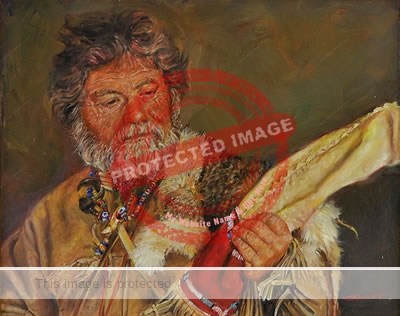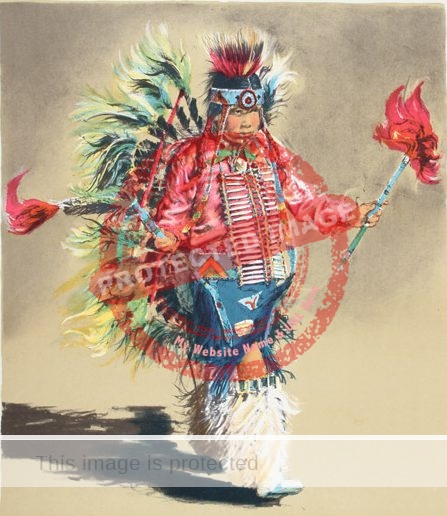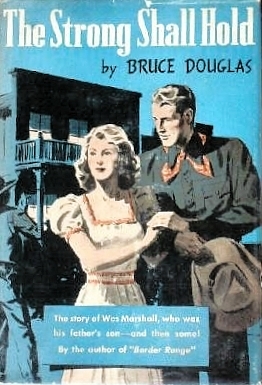The renowned western artist John A. Bruce, best known for his portraiture, visited Ajijic on Lake Chapala, probably in the 1960s. His name was recalled by long-time Ajijic visitor Dr. Jim Vaughan when I interviewed him in 1990. Vaughan said that Bruce had drawn a sketch of him, but that it had required several sittings, because Bruce “liked his tequila”. It is unclear how long Bruce stayed in Ajijic or whether he visited more than once.
John A Bruce was born in Los Angeles, California, on 8 April 1931. He served in the U.S. Army from 1949 to 1952, including 18 months as an infantryman in Korea. Following military service, Bruce began a long career as a commercial artist in California. He worked as Art Director at the Field Service Department, North American Aviation in Downey from 1952 to 1957.
He then worked as an illustrator at Aerojet General Corp., in Sacramento, for three years, before starting his own company, Cal Graphic Advertising in 1960. Cal Graphic lasted three years until 1963 when he became Art Director at Barnes/Chase Advertising, in Santa Ana, a position he held until 1967.
Following Barnes/Chase, he became Vice President of Gil Franzen Art Studio, in Los Angeles (1967-1969) and then Art Director at the Independent Press Telegram, in Long Beach (1969-1973) before once again seeking his independence by becoming a free-lance artist working on Disney’s EPCOT project in Burbank.
Bruce studied art at the Art Center School in Los Angeles and the Chouinard Art Institute, and gained a B.A. in Psychology (with a Minor in Art) from California State university in Los Angeles in 1965.
After the 1970s, Bruce focused more on his own art, as a partial list of his solo and group exhibitions confirms. His solo shows include Ghormley Gallery Los Angeles (1964); Les Li Art Gallery Los Angeles (1969); Upstairs Gallery in Long Beach (1971); and Christine’s of Santa Fe Gallery in Laguna Beach (1993). Invitational. Bruce’s group shows include: Laguna Beach Art Festival Laguna Beach, (1962-1965); Butler Institute of American Art Youngstown, Ohio (1970); Newport Invitational Art Show, Newport Beach (1975); Death Valley Art Show in Death Valley, California (1979-1982); American Indian & Cowboy Artist’s Show in San Dimas, California (1987-1995); El Prado Gallery Sedona, Arizona (1989); Prairie Fire Show Wichita, Kansas (1990-1992); Pepper Tree Art Show, Santa Inez, California (1991 to 1996); San Bernardino Museum, California (1992); AICA (American Indian & Cowboy Artists) at the Autry Museum, Los Angeles (1996-1998); and Wind River Gallery in Aspen, Colorado (1997).
Bruce won numerous awards for his art, including “Best of Show” at Vision 99 – Chicago Windy City Artists (1999), at American Indian & Cowboy Artists (1992; Autry Museum Masters of the American West (1996) and Festival of Western Arts, San Dimas (1996). Artworks by Bruce were adjudged “People’s Choice” at American Indian & Cowboy Artists (1988) and Art of the West Magazine (1992). At American Indian & Cowboy Artists, Bruce won Eagle Feather Awards in 1988 and 1989, and a Gold Medal for Oil Painting in 1992. At the Prairie Fire Art Show in Wichita, Kansas, he won Gold Medals for Drawing in 1990 and 1991 and for Oil Painting 1991. He also won a California International Artist of the Year award in 1975 and the John Grayback Award for Oil Painting at the American Artists Professional League (New York) in 1988. A number of lithographs by Bruce are in the permanent collection of the Smithsonian Institution in Washington, D.C.
Bruce resided in Mariposa, California for many years and continued to find reward in his art. He died peacefully in his sleep there on 12 February 2018. (see comment from his son)
In a 2010 blog post, David Lemon, a fellow member of the American Indian & Cowboy Artists, and friend of Bruce, explained that Bruce suffered serious health set-backs following a fight against cancer and an incident in the V.A. hospital which damaged Bruce’s back and right shoulder. Bruce responded to Lemon’s comments saying that he was not yet able to paint “due to the limited range of motion of my arm” but that he had begun working in charcoal and that it “feels great! I can’t imagine what my life would be like without some art in it.”
Sources:
- The website of John A. Bruce (http://www.bruceart.net/) was visited 5 Jan 2017
- Biography of John Bruce on AskArt.com
- David Lemon. “Story of Courage”. 2010 blog post.
Sombrero Books welcomes comments, corrections or additional material related to any of the writers and artists featured in our series of mini-bios. Please email us or use the comments feature at the bottom of individual posts.



